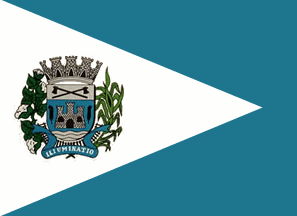 image by Dirk Schönberger,
28 October 2012
image by Dirk Schönberger,
28 October 2012Source: http://www.euclidesdacunha.sp.gov.br/simbolos.php

Last modified: 2012-11-10 by ian macdonald
Keywords: sao paulo | euclides da cunha paulista |
Links: FOTW homepage |
search |
disclaimer and copyright |
write us |
mirrors
 image by Dirk Schönberger,
28 October 2012
image by Dirk Schönberger,
28 October 2012
Source:
http://www.euclidesdacunha.sp.gov.br/simbolos.php
A blue field, with a white triangle extending from the hoist almost to the fly, bearing the municipal arms.
Official website at
http://www.euclidesdacunha.sp.gov.br
Dirk Schönberger,
28 October 2012
The writer, sociologist, journalist, historian and engineer Euclides da Cunha (1866-1909) is the most famous child of Cantagalo. Expelled from the Military College in 1888 for his support to the Republicans, he defended the Republic in the newspaper "O Estado de São Paulo" and was reincorporated into the army after the proclamation of the Republic. When the Canudos uprising broke out in 1897 in the northeast of Bahia, da Cunha first disapproved the uprising, calling it "Our Vendée", as a reference to the monarchist uprising during the French Revolution. Five years later, he published the book "Os Sertões", in which he completely changed his mind, analyzing in depth the causes and outcome of the uprising. In 1905, da Cunha led the Brazilian- Peruvian commission appointed to delimit the border in Amazonia; his posthumous book "À Margem da História" describes the destruction of the primary forest to grow rubber tree. Da Cunha was killed in Rio de Janeiro in a duel or an ambush by Dilermando de Assis, the young lieutenant who was his wife's lover - and married her after the writer's death.
The flag is shown on the official site at http://www.euclidesdacunha.sp.gov.br/simbolos.php
The symbols of Euclides da Cunha Paulista were designed by Lauro Ribeiro Escobar.
The flag is blue with a white triangle charged with the municipal arms. The white triangle represent the aspiration of the municipality to a future made of progress and prosperity. The meaning of the colours is the same as for the coat of arms (see below).
The coat of arms is described as: "Iberic shield azure charged with a castle argent masoned and port and windows sable surrounded by two quills sable, the base wavy argent and sable, the chief argent charged with two machetes sable crossed per saltire. The shield surmounted by a mural crown agent of eight towers port and windows sable. The shield supported dexter by a branch of cotton and sinister by a plant of maize, the two leaved and fructed proper. Below the shield rails argent with ties argent and a scroll azure inscribed with the motto 'ILLUMINATIO' argent."
The Iberic shield, used in Portugal at the time of the discovery of
Brazil, evokes the first colonists of the country.
Azure (blue) represents in heraldry justice, beauty, sweetness,
nobleness, vigilance, serenity, constancy, incorruptible firmness,
dignity, zeal and loyalty, characteristic of the inhabitants of the
municipality, who boost the development of the town through their
endless, efficient work.
The castle is the heraldic symbol of greatness, asylum, safety,
magnanimity, support, protection, alluding here to the building used
by the early colonists to rest in a safe place after laborious work.
The quills evoke the noted Brazilian writer Euclides da Cunha, for
which the municipality was named, as well as literature, education and
eternal fame.
The chief is the first of the first order divisions of the shield;
argent means felicity, purity, temperance, beauty, truth, frankness,
integrity and friendship characteristic of the atmosphere of
understanding and harmony in the municipality.
The machetes are the symbols of work, recalling the early extraction
of timber, especially to build ties for railways. Sable (black)
represents prudence, strength, constancy, simplicity, wisdom, science,
gravity, honesty, firmness, moderation, silence and secret.
The base represents the water resources of the municipality, located
on the banks of the tortuous river Paranapanema and close to Paraná.
The mural crown is the symbol of municipalities. The open gates sable
(black) emphasizes the hospitality of the inhabitants of the town.
The cotton and maize plants represent the soil fertility and a main
source of income. The rails recall that the Sorocabana Railway
initiated the settlement of the region.
The motto "Illuminatio" means clarity, light, enlightenment.
Ivan Sache, 1 November 2012
Anything below the following line isnt part of the Flags of the World Website and was added by the hoster of this mirror.




